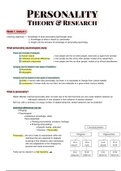Week 1, lecture 1
:
Learning objectives: 1. Knowledge of what personality psychologist study
2. Knowledge of what is meant by ‘personality’
3. Insight into the domains of knowledge of personality psychology
What personality psychologists study
There are 3 levels of analysis:
1. Human nature = how people are like all other people, what sets us apart from animals
2. Individual and group differences = how people are like some other people, looked at by researchers
3. Individual uniqueness = how people are like no other people, looked at by clinical practitioners
Analysis can be based in two types of traditions:
1. Nomothetic
2. Idiographic
Analysis can be based on two types of assumptions:
1. Entity = Human traits (like personality) are fixed, it is impossible to change them (nature beliefs)
2. Incremental = Human traits are not fixed, but are malleable to a great extent (nurture beliefs)
What is personality?
Walter Mischel: Claimed personality does not exist due to the fact that there are very weak relations between an
individual’s behavior in one situation & their behavior in another situation
Not true, with a summary of a large number of related behaviors, similar behaviors can be predicted
Individual differences can be:
Physical
-
Psychological
Intellectual (knowledge, skills)
: Non-intellectual:
Fleeting (momentarily; emotions, feelings)
: Enduring (long-lasting):
- Specific (habits, attitudes)
I
General = Personality!
Personality = the set of traits & mechanisms within the
individual that are organized & relatively
enduring & that influence ones interactions
with and adaptations to the intrapsychic,
physical and social environment.
Traits can be viewed in a trait hierarchy —>
Tf
, Personality explained in a diagram showing it’s connection to & interaction with the environment:
÷÷÷÷÷¥÷÷÷ ;÷÷÷÷s:÷
"
÷
"
is traits . .
:# cultural
to b
:iEEe¥¥¥÷¥ifai
s
dispositional #
oy.ge?e.ndgggision
rules
erection
I.
fld apt to the environment 2 . Adapt the
environment
¥9 iii. aeni.ro?rmeiiisi
- "
anger:* ,
adaptation
t.L-emoaniaeioia.iire.aiioiiiroiiiiii.int
This diagram gives us the 6 domains of personality psychology:
'
Dispositional Cognitive/experiential
Biological
Intrapsychic
:
Social & Cultural
Adjustment
Week 1, lecture 2
Learning objectives: 1. The difference between personality typologies & personality dimensions
2. What the lexical approach can tell us about personality
3. The main characteristics of and differences between the big 5 & the HEXACO model
Personality typologies & personality dimensions
Typologies in history:
1. Four temperaments of Hippocrates
= states there are 4 fundamental personalities based
on bodily fluids and seasons (no evidence) Dimensions vs. types:
IM
÷ ÷ :÷ ÷ ÷ i÷ team
.
, 2. Sheldon’s somatotype typology
= states that there are 3 types based on 3 body types which have been shaped by the way the embryo
has developed (no evidence, largely based on stereotypes)
3. Myers-Briggs Type Indicator (MBTI) (Jung’s typology)
= states there are four dichotomies that can create in total 16
combinations of personalities
Lexical approach, big 5 & HEXACO
The lexical approach is based on the lexical hypothesis:
1. Individual differences that are important will have been put into language
2. The more important an individual difference is, the more languages will
have one or more words for it
3. Dictionaries provide a repository of words related to these individual differences
In 1936 the lexical approach was performed:
—>
BE But! Words that described physical appearance, intellectual capacities, temporary moods & strong judgements
(e.g. abnormal, bad) were removed (see lecture 1; these concepts aren’t included in personality)
Through correlational research of lexical studies, Goldberg found 5 factors to personality, called the big 5:
1. Surgency (extroversion)
2. Agreeableness
3. Conscientiousness
4. Emotional stability (neuroticism)
5. Intellect (openness)
Questionnaires that measure the big 5:
NEO-PI-R (= neuroticism, extraversion, openness - personality inventory - revised)
: FFPI (= five factor personality inventory)
Since then, more lexical studies have been conducted = new model = HEXACO, this model includes 6 factors:
1. Honest-humility
2. Emotionality
3. eXtraversion
4. Agreeableness
5. Conscientiousness
6. Openness to experience
Differences to the big 5:
I Additional 6th dimension (honesty-humility)
- Re-ordering of Agreeableness & Emotional Stability
“Irritation” moves from Emotionality in the big
5, to Agreeableness in HEXACO
“sentimentality” moves from Agreeableness
in the big 5, to Emotionality in HEXACO
HEXACO theory proposes individual differences in:
Engagement (extraversion, conscientiousness & openness)
-
Altruism (honesty-humility, agreeableness, emotionality)
/
It is unlikely that human behavior is bimodal on every dimension, but it
may be possible that clusters of personality types can be found





